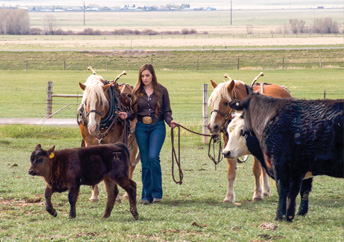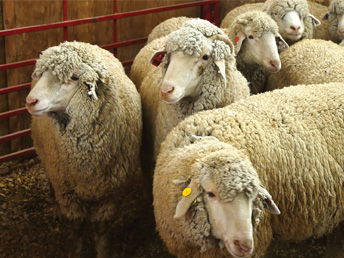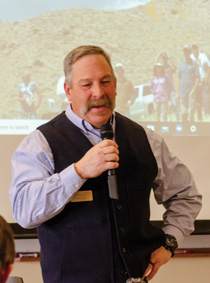
Serving Students and the State
October 10, 2022

UW alumna Katie Shockley leads Pistol and Pete, the College of Agriculture, Life Sciences
and Natural Resources haflinger team, at the Laramie Research and Extension Center.
(Photo courtesy of UW Extension)
From working with ranchers to studying contagious diseases, the College of Agriculture, Life Sciences and Natural Resources is always innovating.
By Micaela Myers
Wyoming producers operate some of the largest farms and ranches in the U.S., and the state’s agriculture is an important sector that continues to grow. The University of Wyoming College of Agriculture, Life Sciences and Natural Resources, home to UW Extension, plays a key role in serving producers and educating the next generation of leaders. Here, we highlight a few new and existing programs that exemplify that work.
Big on Beef Production
“The beef industry has a prominent history in Wyoming, and it’s the largest component of Wyoming agriculture,” says Assistant Professor and Extension Beef Specialist Shelby Rosasco. “The beef industry in the state is very diverse, and the producers are very passionate.”
UW Extension leads outreach education with offices in 23 counties and on the Wind River Reservation. In addition to her teaching and research, Rosasco works with producers and Extension educators across the state.
“Our goals through Extension are to help ranchers and producers be sustainable,” she says. This includes working with them one-on-one, conducting studies and research about the issues ranchers are facing, and providing educational opportunities, such as webinars, seminars and publications.
“We try to do research that’s focused on serving the beef industry and producers — research that will positively impact their operations or answer concerns they have,” Rosasco says.
Her personal research focuses on strategies to improve cattle reproduction and fertility, including studying nutrition’s impact. Other UW beef researchers include Laramie Research and Extension Director Scott Lake, the center’s Assistant Farm Manager Benjamin Hollinger, meat science Assistant Professor Cody Gifford, animal genetics Assistant Professor Hannah Hollinger and reproductive physiology Assistant Professor Jeremy Block. Their research looks at a variety of issues, including the gut microbiome, embryo transfer, reproduction and high-altitude disease.
Extension is also educating the next generation of ranchers at the weeklong summer Wyoming Ranch Camp, and Rosasco believes UW students — many of whom go on to work at ranches across the state — make a huge positive impact on the Wyoming beef industry.
Wine Country of Wool
Associate Professor and Extension Sheep Specialist Whit Stewart describes Wyoming as the wine country of wool for the state’s outstanding reputation and extensive production in this area.
“We’re fourth in the U.S. in sheep numbers, third in breeding sheep numbers and first overall in total value of wool we produce,” he says. “That gives us a special reputation in lamb and wool production. We have our own regional brand of fine wool and meat sheep breeds that thrive in Wyoming’s rugged landscape. All of that combined makes us a major player in the sheep industry. The country looks to us for sheep industry research, education and outreach.”
In addition to teaching and research, Stewart works directly with sheep producers in the state. Similar to the beef program, research focuses on addressing producer issues and needs.

The Laramie Research and Extension Center is home to a flock of over 400 ewes. (Photo
courtesy of UW Extension)
“I consider us a really grassroots-driven research and outreach program,” he says. “What makes us unique is we have our on-campus research done with our flock here at the Laramie Research and Extension Center, but we also have the state as our lab.”
A recent study of mineral deficiencies in winter grazing involved 28 ranches around the state and is giving producers tools to fine-tune their flocks’ nutritional management. An ongoing benchmarking study of the cost of production and levels of production will help producers keep their costs in line during this time of rising inflation. At the center, research is looking at areas including udder and maternity health, lamb quality, nutrition and how sheep grazing can be used for fire suppression and to control noxious plants such as larkspur, which is poisonous to cattle. In addition to Stewart, faculty on these projects include Assistant Professor of Animal Genetics Hannah Hollinger, meat science Assistant Professor Cody Gifford and Rangeland Extension Specialist and Associate Professor of Rangeland Management Derek Scasta. In addition, the sheep program works with collaborators nationally and internationally to answer complex problems sheep producers face.
“Those faculty, combined with our graduate and undergraduate students, really are what make it work,” Stewart says, adding that UW students are often recruited from the sheep program prior to graduation — “We’re giving them great experiences to hit the ground running when they enter the workforce.”
UW’s flock includes over 400 ewes. The sheep program recently became the first operation to reach Level III (certified) status in the American Sheep Industry Association’s American Wool Assurance Program, leading the way for Wyoming producers to also become certified. Graduate student Courtney Newman, of Fort Collins, Colo., was instrumental in the certification process and the sheep program’s partnership with UW’s Center for Blockchain and Digital Innovation.
As part of the Wyoming Wool Initiative, wool from the center’s flock is sent to the Mountain Meadow Wool mill in Buffalo. The resulting custom blankets have a QR code tag that uses blockchain technology for authenticity and traceability and to show the purchaser production information. Proceeds help fund sheep industry marketing and manufacturing innovations in Wyoming while training the next generation of sheep industry professionals.

UW Extension Director Kelly Crane speaks during a session of the 2022 Ranch Management
& Agriculture Leadership Program seminar series. (Photo courtesy of UW Extension)
Ranch Management and Agriculture Leadership Program
Education must change with the times. Future ranch managers, wildland and recreation professionals, and other leaders in agricultural need a diverse range of skills. In response to these workforce needs, UW launched the new Ranch Management and Agriculture Leadership Program with a $1.5 million gift from Farm Credit Services of America doubled by the state of Wyoming. The program targets UW students as well as those already working in the industry with professional development and certification, as well as a future bachelor’s degree and postbaccalaureate offerings. Each level incorporates workforce development, practical experiences, research-based technical knowledge and real-world problem-solving through interactions with industry leaders.
To start things off, the professional development offerings were combined with a class for UW students this past winter that included events in Sheridan, Casper, Riverton, Laramie and Evanston. Students participated via video call so they could interact with the live audience.
“We had live presentations and panel discussions on various topics, including leadership, beef production and markets, cooperative efforts to address complicated natural resource issues, habitat and nutrition considerations,” says UW Extension Director and Associate Dean Kelly Crane, who is also interim director of the program. “It’s been a resounding success. Our students who took the seminar really enjoyed it. Two said it was the most impactful class they had at the university, with the chance to interact with practitioners around the state.”
The professionals, such as agency leaders and ranchers, were likewise impressed by the students.
The Ranch Management and Agriculture Leadership Program will leverage partnerships on campus with the College of Business, Haub School of Environment and Natural Resources and the Wyoming Outdoor Recreation, Tourism and Hospitality Initiative. While other universities offer ranch management programs, UW’s will focus on issues unique to the region.
“It’s more than growing cows and making money,” Crane says. “Most large ranches in this region balance endangered species, public and private lands intermixing, amenity values, hunting, tourism, and oil and gas development. Our program will teach students how to balance all those.”
The undergraduate degree is rolling out this year, and a center will be established in the future along with graduate offerings. An advisory board of professionals will help guide the programming. Networking and connections with ranch managers and agency leaders will be key.
Crane says, “We’re really going to try to use the expertise we have in this state to help educate our students.”
State-of-the-Art Lab
Earlier this year, UW unveiled its new Biocontainment Facility, a biosafety level 3 laboratory (BSL-3) designed for the safe study of animal bacteria, viruses and toxins that must be contained due to their potential for use as bioterrorism agents.
“I think what’s important about this particular facility is that it really opens up avenues of scientific investigation we have not been able to achieve thus far,” says veterinary sciences Assistant Professor Elizabeth Case, the facility’s director. “In the state of Wyoming, we will be able to directly address concerns of infectious disease that affect animals, both domestic and wild, and human health as well.”
Examples of diseases researchers will study include brucellosis and Q fever, which cause spontaneous abortion in wildlife and livestock; Yersinia pestis, which causes black plague; and tularemia, which resembles the plague. In addition to infecting animals, these diseases can make humans sick or even cause death.
“In order to safely diagnose infections and also do research to come up with new tools or interventions, we need a lab that lets us work safely with these agents,” Case says.
Safety infrastructure includes filters to trap any airborne organisms, a wastewater disinfection system, an autoclave for sterilizing solid waste, an incinerator large enough to incinerate two adult bison at the same time, a crane for moving carcasses, and a system that can disinfect the entire facility. This level of facility requires stringent security measures and government oversight by the Centers for Disease Control and Federal Bureau of Investigation.
“In the facility, we have two lab spaces designed to work with cell culture, bacterial culture and molecular experiments,” Case says. “Then we have an additional lab that has a class 3 biosafety cabinet, which is a box with gloves you put your hands in to work with the samples. The research we have planned immediately is to take some of those wild strains we have accumulated and start culturing them so we can sequence their DNA and compare the strains. Right now we’re getting a brucellosis sequencing program off the ground.”
In addition to serving the state and responding to outbreaks, the lab will enable these new realms of research.
